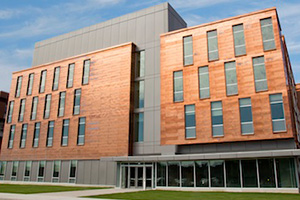How dangerous is radon gas? UOIT researchers share some facts
June 6, 2014

Two University of Ontario Institute of Technology (UOIT) researchers are weighing in on claims made in a recent news report about the prevalence of radon gas in Canadian homes, and a suggestion that radon gas kills more than 3,000 Canadians a year.
Dr. Ed Waller is a Professor in UOIT’s Faculty of Energy Systems and Nuclear Science (FESNS), and is currently an NSERC/UNENE Industrial Research Chair Health Physics and Environmental Safety. Dr. Waller collaborates with the Senior Chair holder, Dr. Anthony Waker, also a Professor (radiation protection science) with UOIT’s FESNS.
“Humans have been exposed to levels of ionizing radiation since the dawn of time, however, some places on the Earth have much higher natural background radiation, with no observed ill effects to the population,” said Dr. Waller.
Radon is a radioactive gas emitted naturally through the decay of uranium in soil. Uranium is a naturally occurring element commonly found in very small amounts in rock, soil, water, plants and animals (including humans).
“Some modern homes have been made so energy-efficient that they do not breathe, and radon builds up,” said Dr. Waller. “Non-breathable living space is actually poor construction. You want to have a positive pressure in your house to vent to the outside, or ventilation to move air from inside to outside. However, as I wrote in a chapter for Springer Encyclopedia of Sustainability Science and Technology, the average indoor radon concentration in Canada is actually measured to be quite low. The higher levels presented in the CBC article should be mitigated, especially if they are in living space.”
UOIT’s program in Health Physics and Radiation Science is one of the few undergraduate degree offerings in Canada which educates students in the science of radiation protection including such public health issues as radon gas. The university also has a strong research program in microdosimetry: the study of possible differences between one radiation type and another which examines how radiation energy is delivered at the cellular level.
“Radon gas involves radiation dose from alpha particles which are densely ionizing, what we call high linear energy transfer (LET) or high-LET radiation,” said Dr. Waker. “But most risk estimates for cancer have been deduced from low-LET radiation (gamma rays) experienced by atomic bomb survivors.”
For radiation delivered at the cellular level, Dr. Waker says the higher the LET, the fewer the cells actually affected. Damage to those fewer cells will be greater, but at the moment no one can clearly say if this increases the risk for cancer.
“There is controversy about the risks of low-level exposure to radon and what the risks are,” said Dr. Waker. “Evidence from plutonium workers in the former Soviet Union suggests a possible threshold for cancer effects from alpha particle exposure. But more research is clearly needed and we are contributing to that.”
“Cancers attributed to radon exposure are purely hypothetical numbers based upon calculations using the not-universally accepted concept of a linear non-threshold risk-dose relationship,” said Dr. Waller. “Radiation does not produce a uniquely identifiable form of cancer. The fact is, there is no way to attribute an individual lung cancer to radiation exposure or suggest 3,000 annual lung cancer deaths due to radon alone. It is highly dubious to proclaim ‘no level of radiation exposure is safe’.”
“Because of Canada’s geography, radon levels will vary greatly and concentrations will be high in some locations,” said Dr. Waker. “If I were living in an area with known high levels of uranium, I would get my home tested and consider remediation if the levels were high. But people should not become overanxious: many daily activities such as driving to work carry far greater risks. I recommend adopting a sensibly cautious approach similar to the Scandinavians where radon concentrations of 400 becquerels* per cubic metre (Bq/m3) (twice the Canadian limit) require mandatory remediation.”
*A becquerel is a unit of radioactivity of a material in which one nucleus decays per second.



